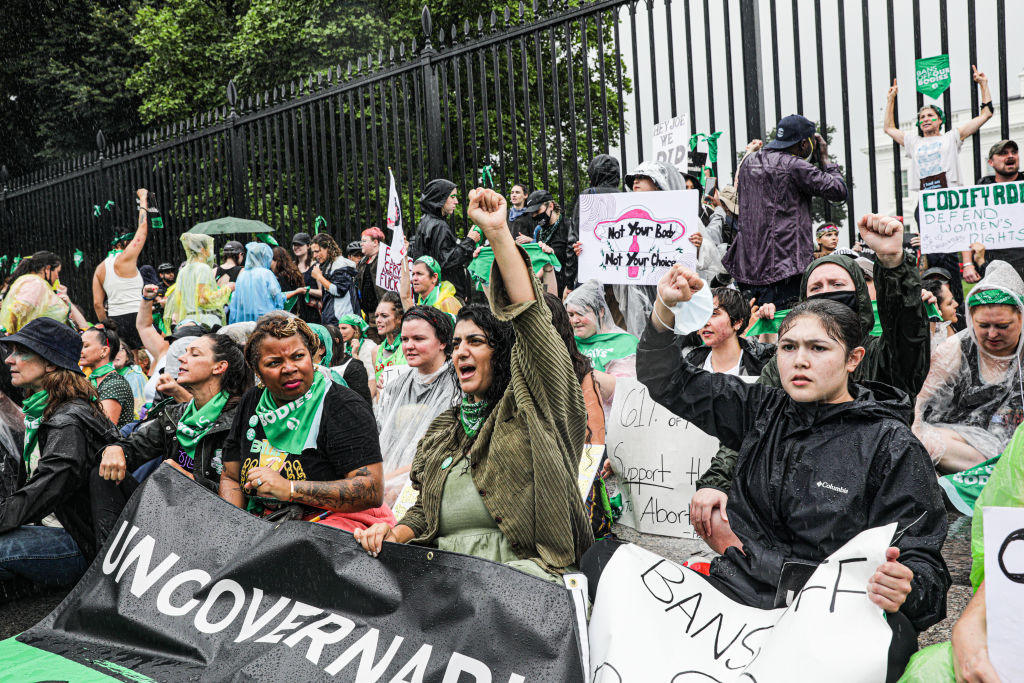
Rutland is the founder of Income Movement, an organization building broad grassroots coalitions in support of basic income.
When I was in my third year of college, I had an abortion. I was several months into a relationship with the man who would later become my husband. During one of the most important times in my life, birth control failed us.
I had my abortion in 1999. At the time, I was working 30 hours a week, taking a full load of classes, and using Pell Grants and student loans to cover the gaps. The cost for an abortion was expensive, more than $500. Even with my partner helping cover costs, this was a significant shock to my ability to cover my regular monthly living expenses. But I was lucky. My fall student loan disbursement coincided with my finding out I was pregnant. Having that cash meant I could afford the abortion, and exercise autonomy over my own body and life.
While it’s been more than two decades, I’ve been thinking about this situation often with the end of Roe v. Wade. As the head of an organization fighting for basic income, I know first-hand how crucial extra cash will be to women in need of abortion and the extra costs they’ll have to incur to receive one if they live in one of the majority of states poised to outlaw abortion. A guaranteed income is not an alternative to abortion access, but it will certainly help women overcome the tremendous barriers they’ll face with the end of legal abortion rights.
Just like it was for me, the cost of an abortion for millions of women is already prohibitive, or creates a shock to their financial lives in ways that can have long-term impact. We need a federally-funded guaranteed income program, similar to the unrestricted cash distributed through last year’s expanded Child Tax Credit, to help women in states outlawing abortion offset the added financial burden they now face.
Second only to abortion laws themselves, financial resources are the primary factor in whether a woman can access an abortion. As a recent Brookings report determined: “Economists provide clear evidence that overturning Roe would prevent large numbers of women experiencing unintended pregnancies—many of whom are low-income and financially vulnerable mothers—from obtaining desired abortions.”
A basic income provides a monthly payment to recipients without restrictions on how it can be spent. Like other forms of income, it is designed to support people as they navigate the ever-shifting landscape of their lives. At its heart, basic income is about changing our country’s punitive, unjust systems toward ones rooted in dignity, trust and freedom. It empowers individuals with agency, just as the right to an abortion does.
Right now, there are more than 80 guaranteed basic income pilots happening across the country. Most pilots offer at least $500 monthly, the average cost of both the abortion pill and a first-trimester procedure, which comprises the vast majority of all abortions. A guaranteed income can also help women living in states that will now ban abortion following the SCOTUS decision to offset those high costs associated with obtaining abortions where it remains legal. We saw this play out in Texas, which recently implemented a near-total abortion ban, where most women seeking an abortion either traveled elsewhere or accessed an abortion pill.
The financial stability of a guaranteed income can also help women afford birth control, which is a major barrier to the uninsured and is even cost-prohibitive in many cases for women who have insurance.
It is critical that when we talk about abortion access we recognize that this is an issue of equity. The act of giving birth poses a significant threat to Black women in the U.S., who have four times the maternal mortality rate as their white counterparts. Additionally, the wide racial wealth and income gaps means women of color are more likely to rely on Medicaid, which does not cover abortion.
Abortion access is inextricably linked to economic security, and—as is the case with all punitive social policies—those who are already marginalized will pay the highest cost. The states where women will face the most restrictions are also the states where women are most likely to be low-income, uninsured and have the highest rates of maternal mortality. Mississippi, home to the case that triggered the overturning of Roe v. Wade, just refused to expand Medicaid to support postpartum low-income mothers.
There is a direct link to women’s ability to access an abortion and their economic prospects, with research finding women who wanted an abortion but were unable to—and their subsequent children—are four times more likely to live under the poverty line.
Guaranteed income is a proven antidote to poverty and increasing freedom: first year results from the Stockton Economic Empowerment Demonstration found recipients had an increased capacity for agency and self-determination, two things gravely at risk with the rolling back of abortion rights.
After I graduated from college, my husband and I got married and had a child. As I look at my now-teenager, I am thankful that I had access to unrestricted funds so that I could choose when to become a mother.
A guaranteed income is not a replacement for what all women deserve—the protections offered by Roe v. Wade to make their own choices about their bodies. But given the reality that a constitutional right to an abortion has now been rescinded, a guaranteed income is an immediate step we can take in an ongoing fight to support and protect women.
More Must-Reads from TIME
- Cybersecurity Experts Are Sounding the Alarm on DOGE
- Meet the 2025 Women of the Year
- The Harsh Truth About Disability Inclusion
- Why Do More Young Adults Have Cancer?
- Colman Domingo Leads With Radical Love
- How to Get Better at Doing Things Alone
- Michelle Zauner Stares Down the Darkness
Contact us at letters@time.com